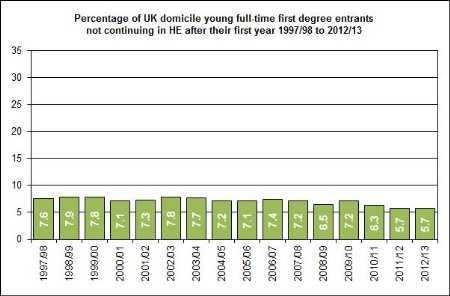The number of new students dropping out of UK universities after their first year stands at less than six per cent, the same as last year, which was the lowest figure since records began.
According to the Higher Education Statistics Agency, just 5.7 per cent of UK-domiciled, young, full-time, first-degree entrants in 2012-13 did not continue in higher education in 2013-14.
The figure peaked in 1998-99, when 7.9 per cent did not continue their studies, and has fallen steadily since 2009-10, when the figure stood at 7.2 per cent.
Hesa statistics released today have also shown that the proportion of new first-time degree entrants from state schools (not including mature students) stood at 89.7 per cent in 2013-14, a record high, and up from 89.3 per cent the year before and 88.9 per cent in 2011-12.
The proportion of these students adjudged to come from the four lowest socio-economic classes stands at 32.6 per cent, also the highest level recorded, with 10.9 per cent from “low-participation neighbourhoods”.
In 1999-2000, just 84.9 per cent of first-degree entrants were from a state school background, meaning that the proportion has risen almost five percentage points in the past 14 years.
The minister for universities, science and cities, Greg Clark, said that the figures showed that “government action to make higher education more accessible is working”.
“We want to see anyone with the ambition and talent go on to higher education, which is why we have removed student number controls and placed more responsibility on universities to widen access,” he said.
However, Sir Peter Lampl, chairman of the Sutton Trust, an educational charity that aims to get more poorer students into selective institutions, said that although he welcomed the increase in the proportion of undergraduates from state schools, a “persistent access gap remains, particularly for Oxbridge and Russell Group universities”.
“Our research shows that those from the most advantaged fifth of communities are more than nine times more likely to go to one of the top universities than the least advantaged two-fifths of neighbourhoods,” he said. “In order to narrow this gap, it is vital that schools continue to improve outreach work and access programmes, including summer schools and a strengthened careers service.”





